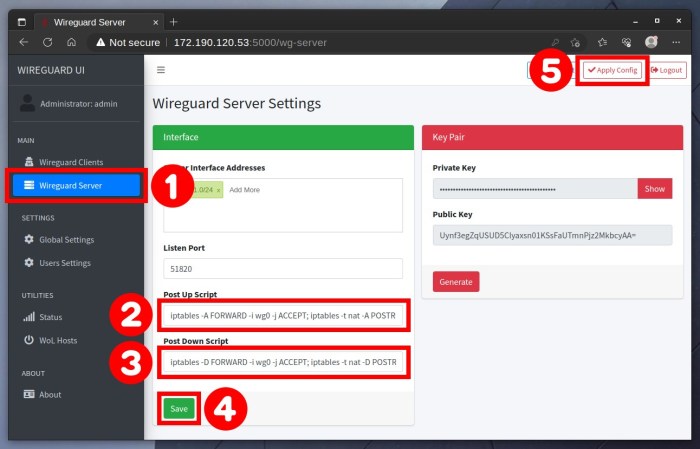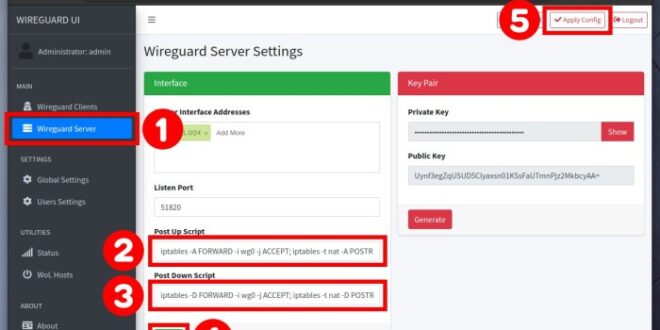In the realm of secure networking, WireGuard has emerged as a game-changer, offering unparalleled speed, simplicity, and security. By harnessing the power of Docker, we can effortlessly deploy WireGuard, extending its capabilities to the world of containerization.
In this comprehensive guide, we’ll delve into the intricacies of setting up WireGuard with Docker, empowering you to establish secure VPN connections, optimize network performance, and mitigate potential security risks.
WireGuard Docker Image Overview
The WireGuard Docker image provides a convenient and portable way to deploy WireGuard VPN servers. It encapsulates the WireGuard software and necessary dependencies into a Docker container, enabling easy deployment and management across various platforms that support Docker.
Utilizing Docker for WireGuard deployment offers several advantages. It simplifies the setup process, allowing for quick and consistent deployment across different environments. Docker also promotes isolation and resource management, ensuring that WireGuard runs in a dedicated and controlled environment, isolated from other applications or processes.
Installation and Configuration
Installing and configuring the WireGuard Docker image is a straightforward process. Follow these steps to set up a WireGuard VPN server using the Docker image:
- Pull the WireGuard Docker image:“`bashdocker pull wireguard/wireguard“`
- Create a WireGuard configuration file:Create a file named `wg0.conf` with the following content:“`bash[Interface]PrivateKey =
Address = /32 ListenPort = [Peer] PublicKey = AllowedIPs = /32 “` Replace ` ` with the private key generated for your WireGuard server, ` ` with the IP address of your server, ` ` with the port you want to use for the VPN, ` ` with the public key of the client you want to connect, and ` ` with the IP address you want to assign to the client. - Run the WireGuard Docker container: “`bash docker run -v /path/to/wg0.conf:/etc/wireguard/wg0.conf wireguard/wireguard wg0 up “` Replace `/path/to/wg0.conf` with the path to the WireGuard configuration file you created in the previous step.
- Add a firewall rule to allow traffic on the VPN port: “`bash sudo ufw allow
“` Replace ` ` with the port you specified in the WireGuard configuration file.
By following these steps, you can set up a WireGuard VPN server using the Docker image and connect to it from your client devices.
Network Configuration

Establishing secure VPN connections with WireGuard requires proper network configuration. This involves understanding and configuring IP addresses, subnets, and routing.
IP Addresses
IP addresses are unique numerical labels assigned to devices on a network. They enable communication between devices by identifying their location on the network. In WireGuard, each device has a private IP address within a specified subnet.
Subnets
A subnet is a portion of an IP address range allocated to a specific network segment. It allows for the logical division of a network into smaller subnetworks, facilitating efficient routing and management.
Routing
Routing is the process of determining the path that data packets take to reach their destination. WireGuard uses routing tables to direct packets between devices on the VPN network. Proper routing configuration ensures that packets are delivered efficiently and securely.
Peer Management
In a WireGuard VPN setup, managing peers is crucial for establishing secure connections between devices. Peers are the endpoints that connect to the VPN, and proper peer management ensures authorized access and prevents unauthorized connections.
WireGuard uses public key cryptography for peer authentication. Each peer generates a public-private key pair. The public key is shared with other peers, while the private key is kept secret. When a peer wants to connect to the VPN, it sends its public key to the server.
The server verifies the public key and generates a shared secret key that is used to encrypt and decrypt traffic between the peers.
Adding Peers
- Generate a public-private key pair for the new peer.
- Add the peer’s public key to the server’s configuration file.
- Add the server’s public key to the new peer’s configuration file.
- Restart the WireGuard service on both the server and the new peer.
Removing Peers
- Remove the peer’s public key from the server’s configuration file.
- Remove the server’s public key from the peer’s configuration file.
- Restart the WireGuard service on both the server and the peer.
Advanced Features
WireGuard Docker offers several advanced features that enhance its functionality and versatility. These include:
Split Tunneling
Split tunneling allows you to selectively route traffic through the WireGuard tunnel while excluding specific destinations. This is useful for optimizing performance and maintaining access to local resources.
NAT Traversal
NAT traversal enables WireGuard to establish connections between devices behind network address translation (NAT) firewalls. This allows you to connect to remote WireGuard peers even when your device is behind a router or firewall.
Firewall Rules
WireGuard Docker allows you to define custom firewall rules to control the flow of traffic through the tunnel. This provides granular control over network access and security.
Troubleshooting

WireGuard Docker setups can occasionally encounter issues. This section provides common troubleshooting tips to help diagnose and resolve problems related to connectivity, performance, or security.
Connectivity Issues
- Check firewall rules: Ensure that firewall rules are configured correctly to allow traffic on the WireGuard port (default: 51820).
- Verify IP addresses: Confirm that the IP addresses assigned to the WireGuard interface are correct and not conflicting with other networks.
- Inspect routing table: Check the routing table to ensure that packets are being routed properly through the WireGuard interface.
Performance Issues
- Optimize MTU: Adjust the MTU (Maximum Transmission Unit) to match the underlying network conditions to improve performance.
- Configure encryption algorithms: Consider using faster encryption algorithms (e.g., ChaCha20) to enhance performance.
- Monitor CPU and memory usage: Ensure that the WireGuard container has sufficient resources to operate efficiently.
Security Issues
- Use strong keys: Generate strong public and private keys for WireGuard to prevent unauthorized access.
- Enable authentication: Implement authentication mechanisms (e.g., preshared keys or certificates) to protect against unauthorized connections.
- Restrict access: Limit access to the WireGuard interface to authorized users and devices to enhance security.
Security Considerations
Utilizing WireGuard Docker comes with potential security implications that need careful consideration.
To ensure a secure VPN setup, adhere to the following best practices:
Secure Key Management
- Generate strong and unique keys for both the server and peers.
- Store keys securely, using tools like HashiCorp Vault or a hardware security module (HSM).
- Regularly rotate keys to mitigate the risk of compromise.
Network Isolation
- Configure the VPN interface on a dedicated subnet, isolated from other networks.
- Use firewall rules to restrict access to the VPN interface only for authorized users.
- Monitor network traffic for suspicious activity and investigate any anomalies promptly.
Authentication and Authorization
- Implement strong authentication mechanisms, such as two-factor authentication (2FA).
- Establish clear authorization policies to control access to the VPN.
- Regularly audit user access and permissions to ensure compliance and identify any potential vulnerabilities.
Regular Updates
- Keep the WireGuard Docker image up to date with the latest security patches and fixes.
- Monitor security advisories and apply necessary updates promptly.
- Regularly review and adjust security configurations based on evolving threats and best practices.
Monitoring and Logging
- Enable logging for the VPN server and peers.
- Monitor logs for suspicious activity, such as failed login attempts or unauthorized access.
- Use tools like SIEM (Security Information and Event Management) to aggregate and analyze logs for potential threats.
Performance Optimization
Maximizing the performance of a WireGuard Docker setup involves optimizing various factors that influence VPN speed and reliability.
To enhance performance, consider the following techniques:
Hardware Optimization
- Utilize a high-performance server with ample CPU cores and RAM to handle encryption and tunneling processes efficiently.
- Select a server with a stable and fast internet connection to ensure reliable data transfer.
Network Configuration
- Configure the MTU (Maximum Transmission Unit) appropriately for the underlying network infrastructure to minimize packet fragmentation and improve performance.
- Enable IP forwarding on the server to allow VPN traffic to be routed correctly.
WireGuard Configuration
- Set the handshake timeout to a suitable value to prevent excessive connection retries.
- Adjust the keepalive interval to maintain a stable connection while minimizing resource consumption.
- Enable fast roaming to allow clients to seamlessly switch between access points without losing connectivity.
DNS Configuration
- Use a fast and reliable DNS server to resolve domain names efficiently.
- Consider using a split-tunnel configuration to route only specific traffic through the VPN, improving performance for non-VPN-bound traffic.
Use Cases
WireGuard Docker is a versatile solution that enables secure remote access and network connectivity for various scenarios. It offers numerous benefits to businesses and individuals, making it a valuable tool for enhancing security and flexibility.
Remote Access
WireGuard Docker allows users to establish secure remote access to their networks, regardless of their physical location. This capability is particularly useful for employees working from home, contractors, or individuals who need to access corporate resources while traveling. By utilizing WireGuard, businesses can provide secure remote access to their employees, enabling them to work efficiently and securely from anywhere.
Network Segmentation
WireGuard Docker can be used to segment networks into isolated and secure zones. This is especially beneficial for organizations that handle sensitive data or require compartmentalization of their network infrastructure. By creating separate WireGuard tunnels for different departments or applications, businesses can enhance network security and reduce the risk of data breaches.
Cloud Connectivity
WireGuard Docker facilitates secure connectivity between on-premises networks and cloud platforms. This capability enables businesses to extend their network infrastructure to the cloud securely, allowing them to leverage cloud services and applications without compromising security. By establishing WireGuard tunnels between their on-premises networks and cloud providers, businesses can ensure secure data transfer and access to cloud resources.
Secure VPN Alternative
WireGuard Docker offers a modern and secure alternative to traditional VPN solutions. It provides a lightweight, fast, and efficient way to establish secure network connections. WireGuard’s advanced encryption and authentication mechanisms ensure the confidentiality and integrity of data transmitted over the network, making it a reliable and secure solution for remote access and network connectivity.
Integration with Other Tools

WireGuard Docker can seamlessly integrate with various other tools and technologies to enhance its functionality and usability.
Docker Compose
Docker Compose allows for the easy management of multiple Docker containers as a single application. By incorporating WireGuard Docker into a Docker Compose configuration, users can quickly establish a secure network among containers, enabling efficient communication and resource sharing.
Kubernetes
Kubernetes is a powerful container orchestration platform that simplifies the deployment and management of containerized applications. Integrating WireGuard Docker with Kubernetes allows for the creation of secure, isolated networks for containers within a Kubernetes cluster. This enhances security and control over container-to-container communication.
Other Orchestration Platforms
WireGuard Docker can also be integrated with other orchestration platforms such as Docker Swarm, Nomad, and Rancher. These integrations enable the deployment of WireGuard networks across multiple hosts, providing a consistent and secure networking infrastructure for distributed applications.
Final Summary
Whether you’re a seasoned network administrator or a novice seeking a secure and reliable VPN solution, this guide will equip you with the knowledge and skills to harness the full potential of WireGuard Docker. Embrace the future of networking and experience the transformative power of secure and efficient connectivity.
